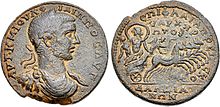Daldis
Daldis (Ancient Greek: Δάλδις, ἡ Δάλδις), was a town on the borders of ancient Lydia and Phrygia,[1] a former bishopric, and is now a Latin Catholic titular see. It also minted coins in antiquity with the legend Δαλδιανων. It also bore the name Flaviocaesaria or Phlabiokaisareia, which is not attested among ancient authors but is reconstructed from epigraphic and other evidence.[2][3]
History[]
The Ancient city of Daldis was located near in Asia Minor (modern Asian Turkey). It was in Lydia.[4] Ramsay[5] believed it was on the Meander River, near the towns of Apollonos-Hieron and Tripolis.
The mother of the ancient Greek philosopher and professional diviner Artemidorus was from Daldis.
The town minted its own coin.[6][7]
It was important enough in the Roman province of Lydia to become a suffragan bishopric of the Metropolitan See of Sardes, but the city latter faded.
Bishopric[]
The diocese was founded in early Roman times and sent delegates to many important councils. Bishops include:
- Paul, attendee at Council of Nicaea[8]
- Theodore attendee at Third Council of Constantinople 680.
- John attended Second Council of Nicaea (787).[9]
- Apiphanius attended the Photius Council (869–870)
The diocese was nominally restored in 1933 as a Latin Catholic titular bishopric. It is vacant, having had the following incumbents, both of the lowest (episcopal) rank:
- Titular Bishop Charles Weber (萬賓來), Divine Word Missionaries (S.V.D.) (1937.12.02 – 1946.04.11), Apostolic Vicar of the then Yizhoufu (December 2, 1937 – April 11, 1946), promoted suffragan Bishop of Yizhoufu (April 11, 1946 – August 7, 1970)
- Titular Bishop Henry Theophilus Klonowski (1947.05.10 – 1977.05.06), Auxiliary Bishop of Scranton (USA) (1947.05.10 – 1973.05.15)
Gallery[]

Coin of Daldis, legend ΔΑΛΔΙΑΝΩΝ, dated to 138-192

Coin of Daldis, legend ΔΑΛΔΙΑΝΩΝ, dated to 193-211

Medallion of Daldis, legend ΔΑΛΔΙΑΝΩΝ, dated to 238-244

Coin of Daldis, legend ΔΑΛΔΙΑΝΩΝ, dated to 244-249
See also[]
- Artimedorus of Daldis, author
- Catholic Church in Turkey
References[]
- ^ Ptolemy. The Geography. 5/2.
- ^ Lund University. Digital Atlas of the Roman Empire.
- ^ Richard Talbert, ed. (2000). Barrington Atlas of the Greek and Roman World. Princeton University Press. p. 56, and directory notes accompanying.
- ^ Joseph Bingham, Origines Ecclesiasticae; Or the Antiquities of the Christian Church and Other Works: In Nine Volumes, Volume 3 (Straker, 1843)p106.
- ^ Sir William Mitchell Ramsay, The Cities and Bishoprics of Phrygia: Being an Essay of the Local History of Phrygia from the Earliest Times to the Turkish Conquest, Volume 2 (Clarendon Press, 1897) p178-179.
- ^ https://www.google.com.au/search?q=Daldis&biw=1280&bih=843&tbm=isch&tbo=u&source=univ&sa=X&ved=0ahUKEwit3vfqoJjQAhXEkpQKHVfNAZkQsAQISQ#imgrc=YRJPB3s3q_j_2M%3A].
- ^ coins of Daldis.
- ^ Richard Price, Michael Gaddis, The Acts of the Council of Chalcedon, Volume 1 (Liverpool University Press, 2005) p336.
- ^ Michel Le Quien, Oriental Christanus, p892.
![]() This article incorporates text from a publication now in the public domain: Smith, William, ed. (1854–1857). "Daldis". Dictionary of Greek and Roman Geography. London: John Murray.
This article incorporates text from a publication now in the public domain: Smith, William, ed. (1854–1857). "Daldis". Dictionary of Greek and Roman Geography. London: John Murray.
External links[]
Coordinates: 38°40′06″N 28°04′31″E / 38.6684°N 28.0752°E
- Catholic titular sees in Asia
- Populated places of the Byzantine Empire
- Roman towns and cities in Turkey
- Former populated places in Turkey
- Populated places in ancient Lydia
- History of Manisa Province




